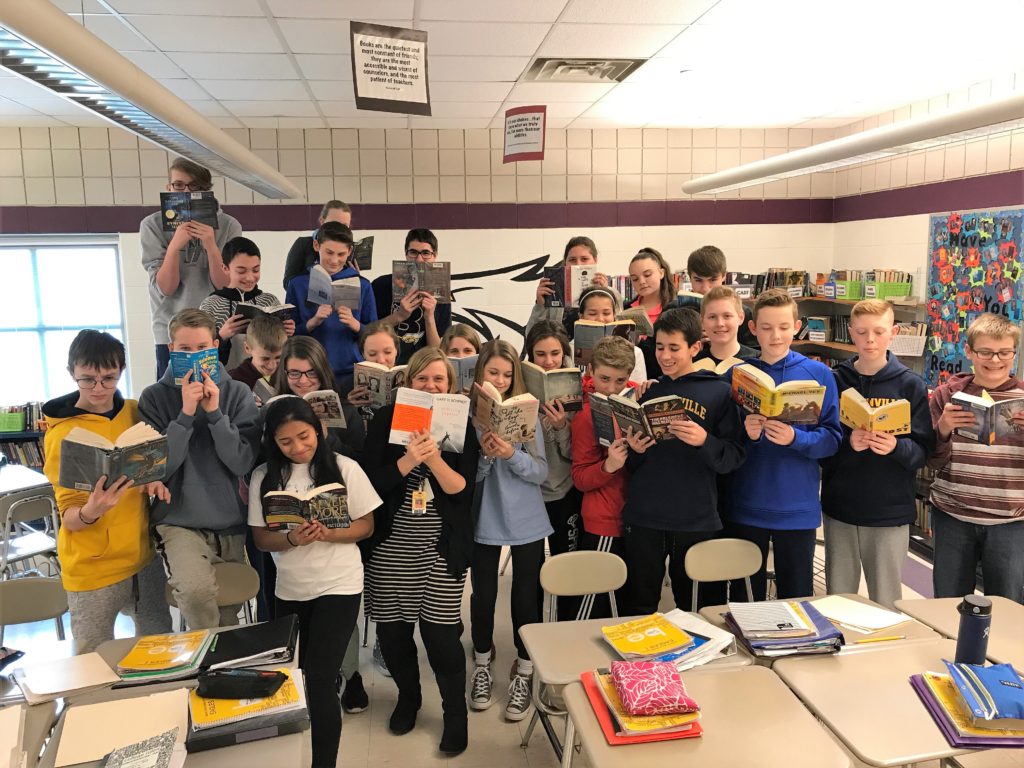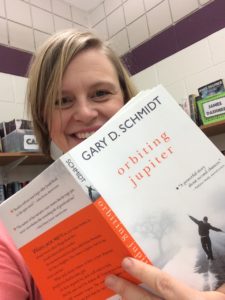
Hands down my favorite moments as a teacher are those of authentic engagement — that rare intersection of attention, curiosity, interest, and passion. Every lesson plan, every strategy, every procedure is an attempt to mix a potion that will help students arrive at this place where learning isn’t a chore and the motivation is intrinsic.
It can happen during a discussion, during writing, but I see it most often in my classroom when it comes to the right book in the right student’s hands. It’s the moment when I have to ask a student to put a book down, when another runs up to me frantic to find the next novel in a series, when I hear a student say to a friend, “You have got to read this.”
After 12 years in the classroom, I understand that I’m still most of all a learner. I never, ever feel like I’ve got things completely figured out, and my middle school students are sure to keep me humble and on my toes.
Yet, by hanging out with some really smart colleagues and paying attention to the research and experts, I have collected some simple strategies — some fertilizers — that often help to grow readers in my classroom and my own home. Here’s three of them:
1.) Expand the definition of reading
Too often, we place unfair limits on what counts as reading. We might insinuate that a book is too short, that another is below a student’s level. Yet, think of all the places in our world where today’s students will encounter the need for different types of literacy, imagine all the places they’ll interpret a variety of messages in a variety of forms. Graphic novels, novels-in-verse, audio books, picture books — all of these are “real” reading.
Here’s just a few favorites in my 8th-grade classroom that don’t fit in the category of traditional novels:
Novels-in-verse:
- Home of the Brave or anything else by Katherine Applegate
- Inside out and Back Again by Thanhha Lai
- Brown Girl Dreaming by Jacqueline Woodson
- The Crossover or anything else by Kwame Alexander
- All the Broken Pieces by Ann E. Burg
Graphic novels
- March Trilogy (Civil Rights) by John Lewis and Andrew Aydin
- Resistance Trilogy (WWII) by Carla Jablonski & Leland Purvis
- El Deafo by Cece Bell
Informational Fun
- How they Croaked and How They Choked by Georgia Bragg
2. Resist book shaming
Similarly, sometimes we turn our nose at certain books that we think aren’t serious enough or kids should be done with by now. While we definitely want to keep pushing kids out of comfort zones or toward more challenging literature, there is nothing wrong with them picking up an easier or less serious book from time to time. As a reader myself, there are times I’m up for a book that will simply make me laugh out loud or a fun beach read, especially if I’ve just finished something heavy and heady. Or, as teacher, author and advoate Penny Kittle calls it, I enjoy “riding the reading rollercoaster.” I instinctively move up and down between books of varying levels, genres, subjects.
When a new Diary of a Wimpy Kid book comes out, I have dozens of students lined up to read it. My 8th graders grew up on this series and it’s like comfort food to them. If they want to spend a few hours doing some easy, enjoyable reading, (instead of playing Fort Night or texting) there is no way I’d deny them of that. And, if we’re nudging them along and allowing them to choose books they enjoy, we know that they’ll naturally grab something else off the shelf later.
I recently asked my students to send me “shelfies” (selfies of themselves with books) during March is Reading Month, along with a quick statement of #whyiread. When I snapped a picture of my nine-year-old with a book in his hand and asked him why he reads, he simply said, “It’s chill.” Life is busy enough — let’s allow books be an escape, not an assignment or obligation.
3. Read-Alouds aren’t just for pre-schoolers
I posted this article on Facebook a few weeks ago after a friend shared it. It emphasizes the importance — and enjoyment — of read alouds at any age. Too often, it’s assumed that once kids can read for themselves, they don’t want or need to hear books read aloud anymore. But the research shows that reading aloud at any age is helpful — and beneficial for all involved. It’s inside of a book read aloud that students find space for questions that they might not normally stop to ask. Unlike a movie or TV show, reading aloud allows space to stop, discuss, and question. It gives me a window into not just my kids’ comprehension, but their minds and hearts, too.
Recently, pressed for time to finish all my required and book club reading, I joined Audible and tried my first audiobook. I’m now addicted to listening to books while I drive, while I get ready in the morning, or while taking my dog for a walk. It feels like a luxury — and a perfect escape — to have someone simply tell me a good story.
—
Look for bad news about today’s youth — and you’re sure to find it. But I can assure you that in my classroom I see hope in the form of readers every day. I see kids conquering a series they thought would be too hard, I hear kids who claim they hate reading admit something is “not so bad,” and I watch a few students reaching for classics like The Odyssey and Pride and Prejudice by choice.
When we make space for all kinds of readers and reading, we see those carefully planted seeds take off and bloom.
 P.S. One more book recommendation — my shelfie — this book gets all the stars from me!
P.S. One more book recommendation — my shelfie — this book gets all the stars from me!
Wonderful, Dana! I am smitten with this blog entry. You just released me from a few preconceived notions about how to direct my young readers. Thank you!
By the way, I am sure your colleagues still consider themselves learners as well and seek your company simply to glean.
Love, love, love! Practical wisdom; thanks for sharing!